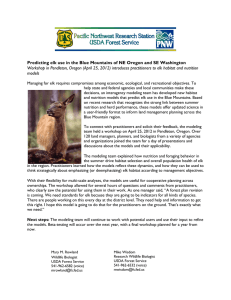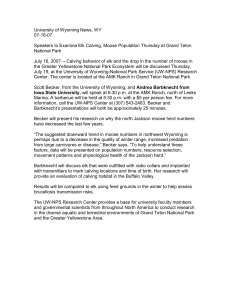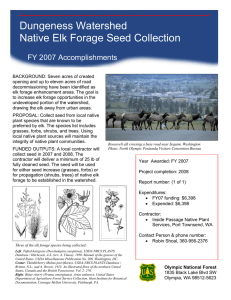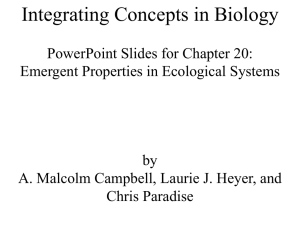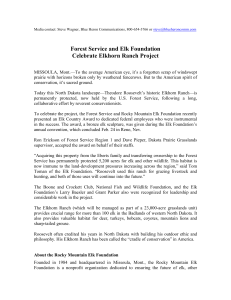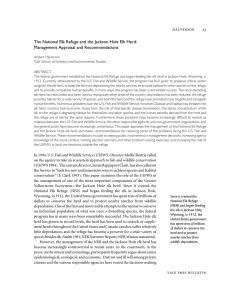Bulletin Series Developing Sustainable Management Policy for the National Elk Refuge, Wyoming
advertisement
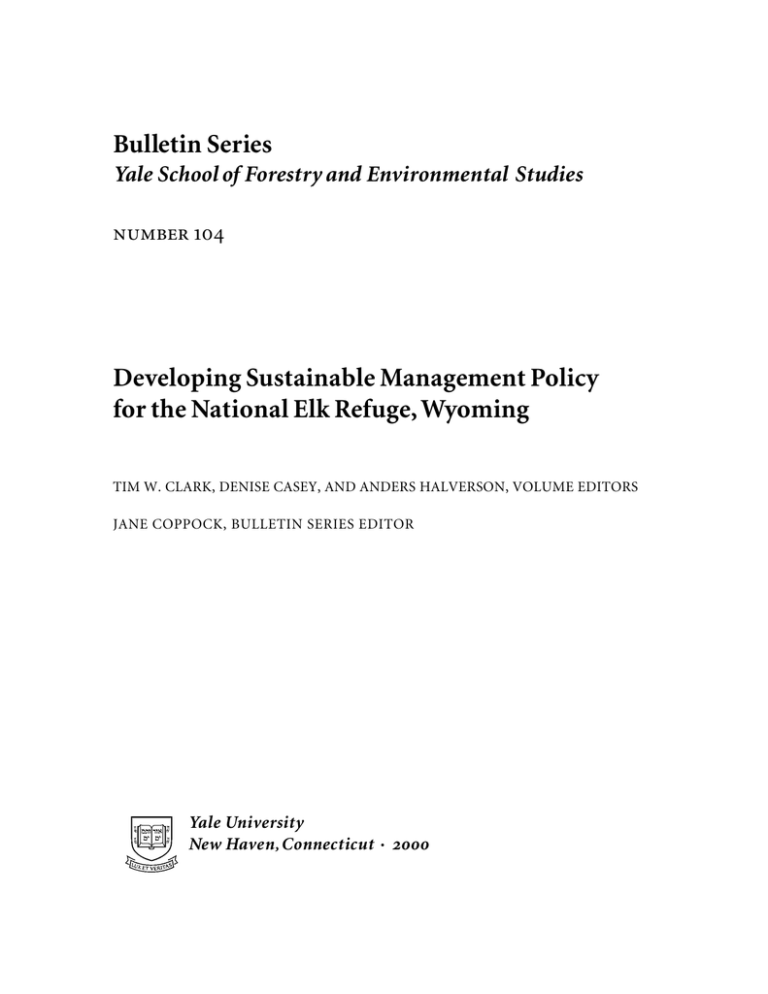
Bulletin Series Yale School of Forestry and Environmental Studies Developing Sustainable Management Policy for the National Elk Refuge, Wyoming TIM W. CLARK, DENISE CASEY, AND ANDERS HALVERSON, VOLUME EDITORS JANE COPPOCK, BULLETIN SERIES EDITOR Yale University New Haven , Connecticut • 2000 This volume was published as a cooperative effort of the Northern Rockies Conservation Cooperative of Jackson, Wyoming, the Yale School of Forestry and Environmental Studies, and many other organizations and people. The Yale School of Forestry and Environmental Studies Bulletin Series, begun in 1912, publishes student and faculty monographs, symposia, workshop proceedings, and other reports of environmental interest. Its aim is to contribute to improved natural resource management and policy. To order copies, contact: http://www.yale.edu/environment/publications or Yale School of Forestry and Environmental Studies Bulletin Series Sage Hall 205 Prospect Street New Haven, Connecticut 06511, USA or Northern Rockies Conservation Cooperative P. O. Box 2705 Jackson, Wyoming 83001 Volume Editors Tim Clark, Denise Casey, and Anders Halverson Bulletin Series Editor Jane Coppock Bulletin Design R. Richard Solaski Production Peggy Sullivan, Sullivan Graphic Design Printing Yale University Reprographics and Imaging Services (RIS) Cover Image Jackie Gilmore Cover Design Russell Shaddox, Yale RIS Paper Mohawk Vellum, Cream White, 60 lb. text, acid free, recycled Produced with support from the: Northern Rockies Conservation Cooperative Bulletin Number ISSN - CODEN BYSSDM © Yale University Permission is granted to reproduce this volume without prior written consent. Contents WELCOME TO READERS 4 ACKNOWLEDGMENTS 5 PREFACE 7 INTRODUCTION Tim W. Clark and Garry D. Brewer 9 The National Elk Refuge and the Jackson Hole Elk Herd: Management Appraisal and Recommendations Anders Halverson 23 Historic Elk Migrations Around Jackson Hole, Wyoming Christina M. Cromley 53 Developing Sustainable Management Practices: Lessons from the Jackson Hole Bison Management Planning Process Christina M. Cromley 66 Biodiversity and its Management on the National Elk Refuge, Wyoming Noah Matson 101 Uses and Valuation of the National Elk Refuge, Wyoming H. Bradley Kahn 139 Wildlife Resources: The Elk of Jackson Hole, Wyoming Tim W. Clark 171 APPENDIX Interdisciplinary Problem Solving: Next Steps in the Greater Yellowstone Ecosystem Tim W. Clark ACRONYMS 188 210 Welcome to Readers The board, staff and supporters of the Northern Rockies Conservation Cooperative, including an anonymous donor foundation, helped bring this publication to life. We did so as an act of faith in open dialogue and as an act of hope for a better relationship between people and the elk, birds, wolves, grasses, soil and water found on and around the National Elk Refuge in Jackson Hole, Wyoming. As of this writing, in the year 2000, there is an enormous opportunity before us to make things better. But improvements only come with sustained effort by a critical mass of people. Our faith has already been rewarded by the high quality of work put forth by the authors of this volume and by the facts of its publication and distribution to you. Our hope will be rewarded fully if this bulletin is of material value to you. Thank you for taking time to consider the ideas and information included in this title, and more, thank you for putting this good material to work. Len Carlman Member, Board of Directors Northern Rockies Conservation Cooperative NRCC Board of Directors Tim W. Clark, President Lance Craighead, Vice-President Denise Casey, Secretary-Treasurer Leonard Carlman Staff Peyton Curlee Griffin, Executive Director Anne-Marie Gillesberg, Managing Director Acknowledgments About 100 people contributed information, time, and money to this volume on sustainable management policy for the National Elk Refuge in Jackson Hole, Wyoming. Their knowledge, generosity, and professionalism made this volume possible, and we sincerely appreciate their many varied contributions. They all expressed a keen interest in the future of Jackson Hole’s elk. Barry Reiswig, manager of the National Elk Refuge, and all his staff deserve special acknowledgment. Garry Brewer, formerly director of the University of Michigan’s Erb Environmental Management Institute, and now dean of University Extension, University of California, Berkeley, provided oversight, advice, and resources. Peyton Curlee Griffin, executive director of the Northern Rockies Conservation Cooperative in Jackson, Wyoming, also aided the project in numerous ways. Financial support for the authors’ research and writing, for the “civic dialogue” held in March 1999 in Jackson, for editorial work by Denise Casey, and for participation of the Northern Rockies Conservation Cooperative was provided by many individuals and organizations. These include Gilman Ordway, Kathe Henry and the Scott Opler Foundation, Catherine Patrick, Hope and Bob Stevens and the Fanwood Foundation, the Wiancko Charitable Foundation, the University of Michigan’s Erb Environmental Management Institute, The New-Land Foundation, Theodore Smith and the Henry P. Kendall Foundation, Emily Stevens, Yale University School of Forestry and Environmental Studies, Stephen and Amy Unfried, the Edna Bailey Sussman Fund, and the Carpenter Fund. An anonymous foundation granted us funds for publication of this volume. We thank them for their generosity and encouragement. Institutional assistance came from the National Elk Refuge (U.S. Fish and Wildlife Service). Other agencies also assisted our work, especially the Wyoming Game and Fish Department, the Bridger-Teton National Forest (U.S. Forest Service), and Grand Teton National Park (National Park Service). People working for other organizations also contributed to this volume, including the Teton County Commissioners, the Teton County Planning Department, Jackson Hole Land Trust, Jackson Hole Conservation Alliance, Jackson Hole Chamber of Commerce, Jackson Town Government, Teton County Natural Resource District (now the Teton Conservation District), Wyoming Wildlife Federation, Greater Yellowstone Coalition, Biota Research and Consulting, Inc., Community Foundation of Jackson Hole, Fund for Animals, Inter-Tribal Bison Cooperative, the media, and local outfitters. Many people were interviewed in preparing this volume. They kindly offered their perspectives on elk management. We especially want to thank participants of the “civic dialogue” on elk management held at the National Museum of Wildlife Art on March 23, 1999. Together, these people include: Diane Abendroth, Jim Angell, Mark Berry, Ann Blakley, Joe Bohne, Mike Brennan, Doug Brimmeyer, Steve Brock, Kathy Buchner, Steve Cain, Franz Camenzind, Tom Campbell, Len Carlman, Bertha Chambers-Gillette, Tim Clark, Bill Collins, Christina Cromley, Diane Debinski, Candra Day, Debbie Deslaurier, Lloyd Dorsey, Matthew Ferrari, Walter Fertig, Gary Fralick, Rik Gay, Ralph Gill, Anne-Marie Gillesberg, Paul Gilroy, Dennis Glick, Mark Gocke, Kerry Grande, Peyton Curlee Griffin, Jim Griffin, Anders Halverson, Clifford Hansen, Ann Harvey, Mark Heckert, Kathe Henry, Gene Hoffman, Bernie Holz, Robert Hoskins, Ralph Hudelson, Mike Hunzie, Steve Iobst, Mike Ivie, Chuck Jones, Virginia Jones, Larry Jorgenson, Ted Kerasote, Steve Kilpatrick, John Kremer, Andrea Lococo, Pam Lichtman, Bill Long, Bill Malone, Dana McDaniel-Bonham, Brad Mead, Don Meyers, Jack Neckels, Bill Noblitt, Barney Oldfield, Suzanne Olmstead, Jayne Ottman, Kevin Painter, Deb Patla, Susan Patla, Tom Puchlerz, Bert Raynes, Albert Ridgeway, Barry Reiswig, Lisa Robertson, Robert Schiller, Michael Schrotz, Sandy Shuptrine, Dave Simpson, Bruce Smith, Scott Smith, Eric Stone, Jeanne-Marie Souvigney, Meredith Taylor, Angus Thuermer, Jr., Tom Thorne, Tom Toman, Harold Turner, Brian Vilalobos, Adrian Villaruz, Doug Wachob, John Wilbrecht, Darwin Wile, and Doug Woody. We apologize to anyone who may have been inadvertently left out. David Skelly of the Yale School of Forestry and Environmental Studies provided invaluable advice in the biodiversity study. Hank and Marianne Harlow of the University of Wyoming provided information and library materials. Jane Coppock, editor of the Yale School of Forestry and Environmental Studies Bulletin Series, provided great editorial support. Finally, we would like to thank Island Press and editor Joanna Burger and her colleagues for permission to reprint “Wildlife resources: the elk of Jackson Hole, Wyoming,” which will appear as a chapter in the forthcoming book, The commons revisited: an American perspective (Joanna Burger, Elinor Ostrom, Richard B. Norgaard, David Policansky, and Bernard D. Goldstein, eds., Island Press, Washington, 2000). Thanks, too, to Policy Sciences general editor, Jack Montgomery, and environmental editor, Garry Brewer, for permission to reprint “Interdisciplinary problem solving: next steps in the Greater Yellowstone Ecosystem” as the appendix to this volume. Preface Garry Brewer and Tim Clark have worked cooperatively on improving natural resource management policy in several contexts—endangered species, ecosystem management, and professional problem solving. In early 1998 Garry Brewer, then director of the University of Michigan’s Erb Environmental Management Institute, approached Tim Clark with the idea of pooling resources to address a management problem in Jackson Hole, Wyoming. In turn, Tim—professor at the Yale School of Forestry and Environmental Studies and president of the Northern Rockies Conservation Cooperative in Jackson—approached the manager of the National Elk Refuge, Barry Reiswig, about the possibility of focusing attention on this world-renowned refuge, which supports thousands of elk each winter and many other species year round. In recent years, questions have been raised about what management policies and practices are appropriate for the refuge, how they should be carried out, by whom, and for whose benefit. The timing for this appraisal was opportune. First, rising levels of conflict in recent years in the region highlighted a need to resolve a number of substantive and procedural problems concerning management of the refuge and the elk. Second, the National Wildlife Refuge System Improvement Act, passed by Congress in 1997, calls for comprehensive planning on all wildlife refuges. Third, not only have there been changing uses and values of the refuge in recent decades, but the public has been demanding more involvement in management of natural resources. Fourth, the Department of the Interior decided in 1999 to undertake a multi-year, multimillion-dollar environmental impact statement on management of the National Elk Refuge. Finally, new leaders are emerging who recognize the need and opportunity for change. Overall, these conditions made our collective effort to examine management policy on the refuge highly relevant and useful. It created an opportunity to take stock of past and present policies and to learn how society might manage its resources more sustainably, make more effective policy decisions, and strengthen democratic fundamentals in the future. Thus, with Barry Reiswig’s enthusiastic cooperation and funding from Garry Brewer’s Erb Institute, Tim Clark invited four Yale FES students to spend the summer of 1998 in Jackson to answer four primary questions. Their findings are published as four chapters in the present volume. Anders Halverson looked at the question “How should the elk be managed on the National Elk Refuge?” Christina Cromley asked “What are the lessons from managing bison on the refuge over the last fifteen years?” Noah Matson investigated the question “What is the status of biodiversity on the National Elk Refuge, how can it be monitored, and how can it best be sustainably managed?” Finally, Brad Kahn took on the question “What are the uses and values of the National Elk Refuge?” Additional chapters include Christina Cromley’s history of elk movements in western Wyoming and reprints of two articles by Tim Clark, one describing the lack of a “commons institution” in the elk situation and one providing a regional context for understanding elk management, both of which suggest improvements. The next step was to use the four student papers as the springboard for a “civic dialogue” held on March 23, 1999, at the National Museum of Wildlife Art. Diverse citizens and agency personnel contributed to this day-long conversation about elk and refuge management issues and how to achieve consensus. This program and some of the participants’ reactions to it are described in the introductory chapter of this bulletin. The final step was to approach Jane Coppock, the Editor of the Bulletin Series of the Yale School of Forestry and Environmental Studies, to see if the School would accept our work for publication in the Bulletin Series. Especially because the Series aims to support publication of material that speaks directly to on-the-ground conservation issues, the volume was eagerly accepted and has received financial as well as editorial support from the School. Where to go from here? In late 1999 and early 2000 initial meetings were held among several government agencies for preparation of the environmental impact statement for the National Elk Refuge. This bulletin is being offered now at the outset of the EIS and other planning efforts for several reasons. First, with this volume we invite all those who are interested in the future of the refuge to participate in a constructive civic process. Second, these reports can serve as an information base on which citizens and officials can deliberate about how best to manage the elk and their habitat into the new century. Finally, the bulletin suggests some practical, problem-solving ideas for finding our community’s common interests. We hope that readers with diverse perspectives and needs will use this volume extensively in their deliberations, decisions, and actions. We hope, too, that all participants will come to this important dialogue with open minds, an interest in learning, and a vision of the legacy we want to leave our children. The Editors

